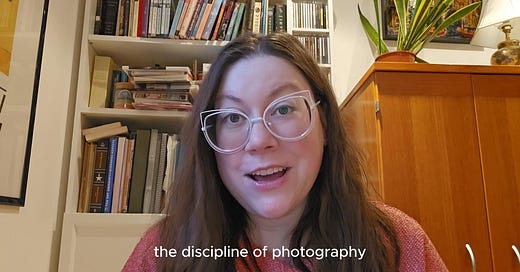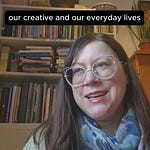Hello friends,
Yesterday we greeted a new moon, which means it is time to move on to our next chapter of exploration: Photography!
Month 2: Photography
We’re continuing the pattern of exploring each creative disciplines from two different angles - and leaning into the magic of that duality.
While the moon waxes, we are going to be exploring pictures (aka ‘still photography’) - and the quality of stillness.
At the full moon, we will turn our investigations towards film and video, and making space for the quality of movement.
Creative Prompt 1: Pictures and Stillness
As you set goals for yourself during this creative adventure, less is more. You will probably get the most out of this experiment if you pick one very small and doable thing. Let that gently blossom, rather than try to take on something large and ambitious.
Your creative task:
Find a way to show us the world through your eyes.
Your life prompt:
Where do you want to cultivate the quality of stillness in your life?
Project ideas:
Choose something important to you and experiment with recording it through a series of pictures.
Try out or refine a new photographic technique (I keep stumbling across videos of people getting interesting shots by flipping their camera phones upside down, and I am intrigued!).
Try capturing the same subject both digitally and with traditional film (the kind that needs to be developed). What differences do you find, both in the process and the product?
Curate a collection of images related to a project or interest of yours.
Choose a work of art to look at (a photograph, perhaps?) and see how still you can become as you look at it. How does this change how you perceive it?
Can you find a protected pattern of stillness within your schedule to honour for the next fortnight? (Maybe first thing in the morning, or at night before going to bed?) What happens within that space? Do you notice any changes in the rest of life that surrounds this ritual of stillness?
We are all photographers now
The advent of the smart phone changed everything - to an extent that even its creator did not anticipate.
In my own experience, it was a fascinating experience to be coming of age during this technological revolution.
I still remember bringing disposable cameras to parties during my first year at University. This had evolved to a digital camera by the time I graduated, and a phone camera not long after that.
Pretty much everyone I know likes to complain about their phone - and with good reason! The level of distraction and volume of input can be absolutely overwhelming.
But our phones also bring us something magical - a power we tend to underestimate. Namely, the ability to capture pictures and video is always right at our fingertips.
The world has evolved around this technology. Increasingly, we communicate through images and recordings instead of just words.
Even as a writer who spends my day focused on words, I’ve found my artistic practice drawing more and more on these areas, out of necessity as well as interest. It is an unescapable form of sharing our work.
Image-making is also a key way that we share our lives. I cherish the videos from my childhood, and am grateful now that I can capture the precious moments of my daughter’s life through the device in my pocket.
If you are someone who struggles to regulate your phone use - it might be interesting this week to explore that relationship by focusing on this one aspect of your gadget:
You have a camera with you at all times.
That means you constantly have the ability to create.
What are you going to do with it?
The power of pictures
Photography works by mimicking the function of our eyes - they both construct images from the way that light bounces off of the world around us.
This means that photography is the closest we can get to looking through another person’s eyes - and to allowing them to look through ours.
We do not just record the world with our pictures. We also shape it.
Images can communicate feelings, tell stories, ask questions, and open space.
A camera is such a beautiful way to demonstrate the value of an artist’s eye. If you hand two different people exactly the same camera, and ask them to take a picture of the same subject, they will still create two different images.
This requires technical skill, but also a skill of simply seeing.
We are not separate from the images that we create - we are expressing ourselves through them.
Seeking stillness
Stillness is essential to the art of taking pictures in two ways.
One: Photos respond to a living, ever changing world by freezing a moment in time - preserving by rendering action into stillness.
Two: Clear photos require a still camera. So in order to capture the world as clearly as we can, we have to find that quality of stillness within ourselves as creators.
Stillness is integral to just about every practice of mindfulness and spirituality. Understandably so. Stepping away from external busyness is a way to look inwards, and to plumb the depths of our own mysterious natures.
Photography invites us to consider stillness from a different and unique angle
What if your deepest essence had a protected moment to be total and completely still? What might come from this gift?
What amount of time feels natural for you to be in stillness?
There is meditative power in sustained stillness. However, just a brief moment of being still can have its own magic.
After all - a moment is all we need to take a picture.
My project this fortnight: cultivating a surreal office setting
I’ve recently had a couple of meetups with friends who work in film - and it has been so interesting to learn about how they approach their work.
From both of them, I’ve been impressed by their creations of really intricate and expressive mood boards.
This is an essential stage of their work, both to discover what is at the essence of their creative project, but also to be able to communicate it to other people.
Witnessing this is fascinating to me, because it really brings home how much I am a ‘words first’ person - always tempted to turn to language.
But I’d like to tap more deeply into my visual imagination. And this fortnight, I’m really interested in exercising this artistic muscle.
There is a musical I am working on that is set in a surreal kind of office. I’m shortly going to kick off a new round of rewriting on it. I have a strong sense of what the show’s world is like, but I am still working from a place of feeling, rather than detailed and fully-realised images.
So this week, I am going to try to take some pictures that I think capture elements of this show. I’m also going to look around at other people’s photographs to curate a collection/vision board. that encourages me to get a bit more specific about these things.
Hopefully, this will encourage exploration of some new ways of interacting with photography in my work, and also set me up really well to tackle this new phase of edits.
Show the world your vision
If you’re open to sharing your images or thoughts, I would love to see what you discover!
Alli
Access Support: If you have access needs that I’m not currently meeting, please do drop me a line! (The best email is contact@ac-smith.com.) I’d really like to make this project available to anyone who wants to participate.














Share this post